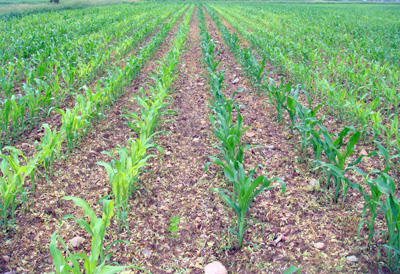By George Silva
In 2015, several corn growers in Ingham County, Michigan, have expressed concerns about excessive striping, or interveinal chlorosis, of leaves. A certain amount of leaf striping in the new growth is noticeable every year. Corn usually grows out of this condition. This year, the symptoms are widespread over many acres and fields and they appear in newer and older leaves. Corn is currently at the V5-V6 growth stage. Affected areas are sometimes interspersed with a patch or row of healthy corn.
Scientific literature suggests corn striping often occurs due to several nutrient deficiencies. These nutrients include sulfur (S), magnesium (mg), zinc (Zn) and manganese (Mn). Symptoms are often similar and difficult to distinguish. Non-nutrient factors are also implicated, such as herbicide injury, root damage, cold temperature, corn genetics, soil pH and soil type. Striping may also appear when a period of rapid growth is followed by a period of slow growth induced by cold weather. With no clear cut evidence, there has been much speculation amongst growers, consultants and fertilizer service providers as to what is causing these symptoms.

Striped corn in Ingham County, Michigan, 2015.

Striped corn in Ingham County, Michigan, 2015. Notice the two middle rows that appear near normal green.
In diagnosing problems of this nature, Michigan State University Extension recommends taking plant tissue and soil samples for nutrient analysis. One reason for this is that for nutrients such as S, the soil test is not reliable. In this case, plant and soil samples were taken from normal and affected areas of the field. Plant tissue samples were sent to A&L Great Lakes Laboratories in Indiana for nutrient analysis. Soil samples were tested at the MSU Soil and Plant Nutrient Laboratory.
By comparing test results with established nutrient sufficiency ranges from good and bad areas, the tissue test should reveal if adequate nutrients have been taken up by the plant. If a nutrient in the tissue is below the sufficiency range, then do the soil test results corroborate any deficiencies or potential nutrient imbalances in the soil? Use of tissue and soil tests help to confirm if the striping is related to a nutrient deficiency.
Based on these results, if the striping is caused by a nutrient deficiency, we may be able to determine if a quick remedial measure such as a foliar spray would still be effective in alleviating this situation. If longer-term measures are needed, those practice could be implemented following harvest.
Source:msu.edu